| Diese Seite auf Deutsch! |
|
Systematik der Truncatelloidea Caenogastropoda > Littorinimorpha > Truncatelloidea |
|
|
Superfamily Truncatelloidea Source: WoRMS: MolluscaBase eds. (2025): Truncatelloidea J.E. GRAY, 1840. |
In Central and Southern Europe, around 40 species of spring snails (Bythinellidae) are known. The five most important German species are primarily defined by anatomical features and are not always distinguishable by shell characteristics alone. In most cases, however, they can be identified by their location of discovery, as each species typically occurs only at specific sites. This method is losing reliability, though, since in countries like Austria, several spring snail species can be found living side by side, even in areas where they were previously thought to be geographically restricted.
The shell colour often appears dark brown due to the growth of diatoms or green due to filamentous green algae. Spring snails can spread via flying insects, on which they deposit their eggs.
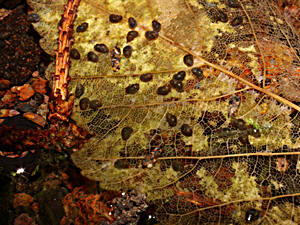 Spring snails (Bythinella compressa) on a leaf. Picture: © Alexander Mrkvicka, Vienna. |
Spring snails are adapted to constant low temperatures (cold-stenothermic) and inhabit mainly springs, upper spring runs, and the headwaters of streams. Their presence is considered an indicator of clean, unpolluted spring water – in pristine habitats, densities can reach several thousand individuals per square metre.
Spring snails are crenobionts, specialists with a narrow ecological tolerance. Even minor deviations from their optimal environmental conditions can lead to population decline or local extinction. At the same time, they are highly adapted to the extreme and nutrient-poor environment of natural springs.
Spring snail species are most often threatened by structural alteration of spring habitats, their use as livestock watering points, drainage and lowering of the groundwater table, but above all by nutrient pollution from agriculture, which leads to eutrophication of the spring water.
Additionally, global warming also leads to an increase in water temperature in springs, with the consequence of a decrease in cold-stenothermal and krenobiotic spring snail populations.
| Distribution area (Germany) | Name |
|---|---|
| Northern Alps, Allgäu, Lech and Isar region | Bythinella bavarica |
| Eastern Alps and Sudeten, Alpine foothills | Bythinella austriaca |
| Rhön and Vogelsberg | Bythinella compressa |
| West Germany, Lower Rhine, Sauerland | Bythinella dunkeri |
| Black Forest | Bythinella badensis |
Austrian Spring Snail - Bythinella austriaca (Frauenfeld 1857)
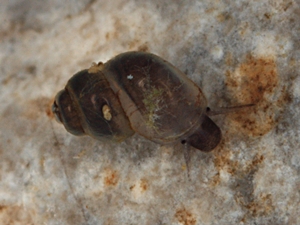 Bythinella cylindrica. Picture: © Alexander Mrkvicka, Vienna. |
Beschreibung: The Austrian spring snail is smaller than Bythinella bavarica (see bewlow). Its whorls are flattened. Also, the suture is less noticeable. The last whorl takes about one fifth of the shell's overall height.
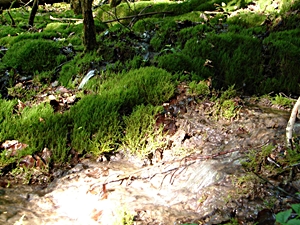 Limestone tuff spring neari Fischbach in the Rhön, Habitat of the Rhön spring snail (Bythinella compressa). Picture: J. Gombert (Source). |
 Different spring snail species. Right: Bythinella cylindrica, left: Belgrandiella wawrai (Hy- drobiidae). Picture: © Alexander Mrkvicka, Vienna. |
Distribution: An important species in springs and low mountain ranges. The Austrian spring snail can be found from the Eastern Bavarian Alps and the Sudeten mountains, through Moravia and Austria as far as Northeastern TRyrol, Styria, Carinthia and further towards Carniola, Hungary and Galicia.
Threat Situation: In Austria, the Austrian spring snail is classified "near threatened. (vgl. Threat categories according to IUCN).
Cylindrical Spring Snail - Bythinella cylindrica (Frauenfeld 1857)
Shell less slender, suture noticeably deepened, whorls bulbous, last whorls taking two thirds of overall shell height.
Size: H: 2,6 - 2,8 mm; W: 1,5 - 1,7 mm.
![]()
Distribution: Northern Alps, Eastern Bavarian limestone Alps and their foothills. From Munich eastward through Bavaria until North Tyrol and the Salzburg country, Pottenstein near Wiener Neustadt (Lower Austria), in the high terraces near Munich.
According to Reischütz, Bythinella cylindrica is to be seen as a subspecies of Bythinella austriaca.
Rhön Spring Snail - Bythinella compressa (Frauenfeld 1857)
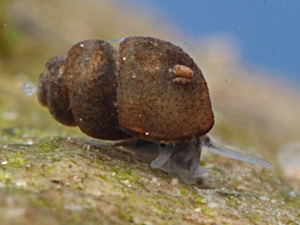 Rhön-Quellschnecke (Bythinella compressa). Bild: © Alexander Mrkvicka, Wien. |
Description: Shell oval, bluntly conical, last whorl taking four fifths of overall shell height, whorls very bulbous, apex obliquely shortened.
Distribution: In Germany: Rhön, Vogelsberg. Present in Austria.
The Rhön spring snail needs evenly cold and unpolluted water (saprobial index 1.0) at a temperature of about 7 - 8 °C. It feeds on algae growth, bacteria and detritus grazed from stones, waterplants, fallen leaves (see picture) and deadwood lying in the water.
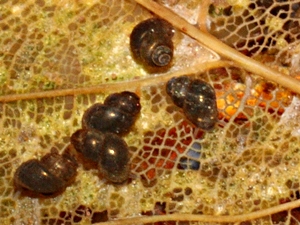 Quellschnecken (Bythinella compressa) auf einem Laubblatt. Bild: © Alexander Mrkvicka, Wien. |
Some time ago, the Rhön spring snail was widely spread in open cultural landscapes. Today, it can only be found left in springs, as well as in spring creeks aome hundred metres downstream in coherent decidual forest areas. In intact habitats there may be population densities of up to 50 snails on a 25 x 25 cm square area.
The populations, however, live isolated from each other. Taking into consideration the species' highly specific habitat needs, deleted populations must be considered irretrievably lost.
![]() Wikipedia:
Rhönquellschnecke.
(In German).
Wikipedia:
Rhönquellschnecke.
(In German).
Bavarian Spring Snail - Bythinella bavarica Clessin 1877
Description: The Bavarian spring snail usually is bigger, highly conical with rounded shell whorls, the last of which is widened. The shell's colour often is greenish because of algae growth. The shell tip (apex) is small and bluntly rounded, the wshell whorls are separated by a deep suture.
Size: H: 4 mm; W: 2,3 mm; N: 4½ - 5.
![]()
Distribution: The Bavarian spring snail needs limestone ground. Its distribution area spreads from the Northern Alps over the Alpine foothills (Lech and Isar regions), as well as eastward from Southern Württemberg to the Inn river and Northern Tyrol.
![]() Geyer,
D.: Unsere Land- und Süßwassermollusken, Stuttgart, 1927, p. 165 ff.
Geyer,
D.: Unsere Land- und Süßwassermollusken, Stuttgart, 1927, p. 165 ff.
![]() Wolfgang
Fischer:
Checklist of Austrian Mollusca.
Wolfgang
Fischer:
Checklist of Austrian Mollusca.
Broad-Lipped Spring Snail - Emmericia patula (Brumati 1838)
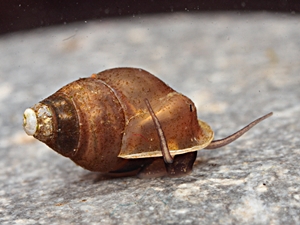 Broad-lipped spring snail (Emmericia patula). Picture: © Alexander Mrkvicka, Vienna. |
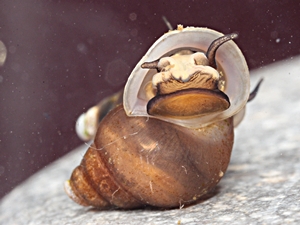 Broad-lipped spring snail (Emmericia patula). Picture: © Alexander Mrkvicka, Vienna. |
Description: The broad-lipped spring snail has a bluntly conical shell, the last whorl of which shows a notable parietal bead. The apertural lip, due to the species' name, is strongly widened. The whorls grow fast in width.
Size: H: 6mm; W: 4 mm. N: 4½ - 5.
![]()
Habitat and Distribution: Emmericia patula lives in springs and streams rich in limestone.
The species' distribution area stretches along the Italian and Yugoslav Adriatic Coasts from Venetia as far as Central Dalmatia. Emmericia patula was introduced to Southern France and Bavaria (Central Francia) by unknown means and also released into the wild in 1960. Today it can also be found near Dachau and in Munich.
![]() Broad-Lipped Spring Snail (Emmericia patula) from the Timavo spring near
Trieste.
Broad-Lipped Spring Snail (Emmericia patula) from the Timavo spring near
Trieste.
![]() Francisco
Welter-Schultes:
Emmericia patula species homepage.
Francisco
Welter-Schultes:
Emmericia patula species homepage.
![]() Molluscs With a Migration Background:
Neobiota.
Molluscs With a Migration Background:
Neobiota.